A Simulation-Optimization Modeling Approach for Conjunctive Water Use Management in a Semi-Arid Region of Iran
Abstract
:1. Introduction
2. Study Area and Data
3. Methodology
3.1. Groundwater Level Simulation
3.2. Conjunctive Use Optimization
3.2.1. Objective Function
3.2.2. Whale Optimization Algorithm (WOA)
3.3. Prediction of Water Shortage
Least Squares-Support Vector Machine (LS-SVM)
4. Results and Discussion
4.1. Simulation Results
4.2. Optimization Results
4.3. Prediction Results
5. Conclusions
Author Contributions
Funding
Institutional Review Board Statement
Informed Consent Statement
Data Availability Statement
Conflicts of Interest
References
- Ekwueme, B.N.; Agunwamba, J.C. Modeling the influence of meteorological variables on runoff in a tropical watershed. Civ. Eng. J. 2020, 6, 2344–2351. [Google Scholar] [CrossRef]
- Ekwueme, B.N.; Agunwamba, J.C. Trend Analysis and variability of air temperature and rainfall in regional river basins. Civ. Eng. J. 2021, 7, 816–826. [Google Scholar] [CrossRef]
- Li, X.; Zhang, K.; Gu, P.; Feng, H.; Yin, Y.; Chen, W.; Cheng, B. Changes in precipitation extremes in the Yangtze River Basin during 1960–2019 and the association with global warming, ENSO, and local effects. Sci. Total Environ. 2021, 760, 144244. [Google Scholar] [CrossRef] [PubMed]
- Javadi, S.; Saatsaz, M.; Shahdany, S.M.H.; Neshat, A.; Milan, S.G.; Akbari, S. A new hybrid framework of site selection for groundwater recharge. Geosci. Front. 2021, 12, 101144. [Google Scholar] [CrossRef]
- Moghaddam, H.K.; Milan, S.G.; Kayhomayoon, Z.; Kivi, Z.R.; Azar, N.A. The prediction of aquifer groundwater level based on spatial clustering approach using machine learning. Environ. Monit. Assess. 2021, 193, 173. [Google Scholar] [CrossRef]
- Milan, S.G.; Roozbahani, A.; Azar, N.A.; Javadi, S. Development of adaptive neuro fuzzy inference system –Evolutionary algorithms hybrid models (ANFIS-EA) for prediction of optimal groundwater exploitation. J. Hydrol. 2021, 598, 126258. [Google Scholar] [CrossRef]
- Pan, D.; Chen, H. Border pollution reduction in China: The role of livestock environmental regulations. China Econ. Rev. 2021, 69, 101681. [Google Scholar] [CrossRef]
- Das, B.; Singh, A.; Panda, S.N.; Yasuda, H. Optimal land and water resources allocation policies for sustainable irrigated agriculture. Land Use Policy 2015, 42, 527–537. [Google Scholar] [CrossRef]
- Kadam, A.; Umrikar, B.; Bhagat, V.; Wagh, V.; Sankua, R.N. Land suitability analysis for afforestation in semi-arid watershed of Western Ghat, India: A groundwater recharge perspective. Geol. Ecol. Landscapes 2021, 5, 136–148. [Google Scholar] [CrossRef]
- Theis, C.V. The effect of a well on the flow of a nearby stream. Trans. Am. Geophys. Union 1941, 22, 734–738. [Google Scholar] [CrossRef] [Green Version]
- Belaineh, G.; Peralta, R.C.; Hughes, T.C. Simulation/optimization modeling for water resources management. J. Water Resour. Plan. Manag. 1999, 125, 154–161. [Google Scholar] [CrossRef]
- Karamouz, M.; Tabari, M.M.R.; Kerachian, R. Application of genetic algorithms and artificial neural networks in conjunctive use of surface and groundwater resources. Water Int. 2007, 32, 163–176. [Google Scholar] [CrossRef]
- Safavi, H.R.; Esmikhani, M. Conjunctive use of surface water and groundwater: Application of Support Vector Machines (SVMs) and genetic algorithms. Water Resour. Manag. 2013, 27, 2623–2644. [Google Scholar] [CrossRef]
- Yousefi, M.; Banihabib, M.E.; Soltani, J.; Roozbahani, A. Multi-objective particle swarm optimization model for conjunctive use of treated wastewater and groundwater. Agric. Water Manag. 2018, 208, 224–231. [Google Scholar] [CrossRef]
- Soleimani, S.; Bozorg-Haddad, O.; Boroomandnia, A.; Loáiciga, H.A. A review of conjunctive GW-SW management by simulation–optimization tools. J. Water Supply Res. Technol. 2021, 70, 239–256. [Google Scholar] [CrossRef]
- Vedula, S.; Mujumdar, P.; Sekhar, G.C. Conjunctive use modeling for multicrop irrigation. Agric. Water Manag. 2005, 73, 193–221. [Google Scholar] [CrossRef] [Green Version]
- Chen, Y.W.; Chang, L.C.; Huang, C.W.; Chu, H.J. Applying genetic algorithm and neural network to the conjunctive use of surface and subsurface water. Water Resour. Manag. 2013, 27, 4731–4757. [Google Scholar] [CrossRef]
- Landa, S.A. Optimizing Sustainable Integrated Use of Groundwater, Surface Water and Reclaimed Water for the Competing Demands of Agricultural Net Return and Urban Population; Utah State University: Logan, UT, USA, 2016. [Google Scholar]
- El-Rawy, M.; Zlotnik, V.A.; Al-Raggad, M.; Al-Maktoumi, A.; Kacimov, A.; Abdalla, O. Conjunctive use of groundwater and surface water resources with aquifer recharge by treated wastewater: Evaluation of management scenarios in the Zarqa River Basin, Jordan. Environ. Earth Sci. 2016, 75, 1146. [Google Scholar] [CrossRef]
- Miao, R.; Liu, Y.; Wu, L.; Wang, D.; Liu, Y.; Miao, Y.; Yang, Z.; Guo, M.; Ma, J. Effects of long-term grazing exclusion on plant and soil properties vary with position in dune systems in the Horqin Sandy Land. Catena 2021, 209, 105860. [Google Scholar] [CrossRef]
- Thammanu, S.; Marod, D.; Han, H.; Bhusal, N.; Asanok, L.; Ketdee, P.; Gaewsingha, N.; Lee, S.; Chung, J. The influence of environmental factors on species composition and distribution in a community forest in Northern Thailand. J. For. Res. 2021, 32, 649–662. [Google Scholar] [CrossRef]
- Peralta, R.C. Simulation/optimization applications and software for optimal ground-water and conjunctive water management. Ground Water Modeling Cent. 2001, 691–694. [Google Scholar]
- Barlow, P.M.; Ahlfeld, D.P.; Dickerman, D.C. Conjunctive-management models for sustained yield of stream-aquifer systems. J. Water Resour. Plan. Manag. 2003, 129, 35–48. [Google Scholar] [CrossRef]
- Safavi, H.R.; Enteshari, S. Conjunctive use of surface and ground water resources using the ant system optimization. Agric. Water Manag. 2016, 173, 23–34. [Google Scholar] [CrossRef]
- Karamouz, M.; Zahraie, B.; Kerachian, R.; Eslami, A. Crop pattern and conjunctive use management: A case study. Irrig. Drain. 2008, 59, 161–173. [Google Scholar] [CrossRef]
- Joodavi, A.; Izady, A.; Maroof, M.T.K.; Majidi, M.; Rossetto, R. Deriving optimal operational policies for off-stream man-made reservoir considering conjunctive use of surface- and groundwater at the Bar dam reservoir (Iran). J. Hydrol. Reg. Stud. 2020, 31, 100725. [Google Scholar] [CrossRef]
- Zeinali, M.; Azari, A.; Heidari, M.M. Multiobjective optimization for water resource management in low-flow areas based on a coupled surface water–groundwater model. J. Water Resour. Plan. Manag. 2020, 146, 04020020. [Google Scholar] [CrossRef]
- Rezaei, F.; Safavi, H.R.; Mirchi, A.; Madani, K. f-MOPSO: An alternative multi-objective PSO algorithm for conjunctive water use management. J. Hydro-Environ. Res. 2017, 14, 1–18. [Google Scholar] [CrossRef]
- Sepahvand, R.; Safavi, H.R.; Rezaei, F. Multi-objective planning for conjunctive use of surface and ground water resources using genetic programming. Water Resour. Manag. 2019, 33, 2123–2137. [Google Scholar] [CrossRef]
- Rezaei, F.; Safavi, H.R. Sustainable conjunctive water use modeling using dual fitness particle swarm optimization algorithm. Water Resour. Manag. 2022. [Google Scholar] [CrossRef]
- Rezaei, F.; Safavi, H.R. f-MOPSO/Div: An improved extreme-point-based multi-objective PSO algorithm applied to a socio-economic-environmental conjunctive water use problem. Environ. Monit. Assess. 2020, 192, 767. [Google Scholar] [CrossRef]
- Mehrabi, A.; Heidarpour, M.; Safavi, H.R.; Rezaei, F. Assessment of the optimized scenarios for economic-environmental conjunctive water use utilizing gravitational search algorithm. Agric. Water Manag. 2021, 246, 106688. [Google Scholar] [CrossRef]
- Ashu, A.B.; Lee, S.-I. Simulation-optimization model for conjunctive management of surface water and groundwater for agricultural use. Water 2021, 13, 3444. [Google Scholar] [CrossRef]
- Safavi, H.R.; Alijanian, M.A. Optimal crop planning and conjunctive use of surface water and groundwater resources using fuzzy dynamic programming. J. Irrig. Drain. Eng. 2011, 137, 383–397. [Google Scholar] [CrossRef]
- Liu, L.; Cui, Y.; Luo, Y. Integrated modeling of conjunctive water use in a canal-well irrigation district in the Lower Yellow River Basin, China. J. Irrig. Drain. Eng. 2013, 139, 775–784. [Google Scholar] [CrossRef]
- Rafipour-Langeroudi, M.; Kerachian, R.; Bazargan-Lari, M.R. Developing operating rules for conjunctive use of surface and groundwater considering the water quality issues. KSCE J. Civ. Eng. 2014, 18, 454–461. [Google Scholar] [CrossRef]
- Singh, A. Simulation–optimization modeling for conjunctive water use management. Agric. Water Manag. 2014, 141, 23–29. [Google Scholar] [CrossRef]
- An-Vo, D.-A.; Mushtaq, S.; Nguyen-Ky, T.; Bundschuh, J.; Tran-Cong, T.; Maraseni, T.N.; Reardon-Smith, K. Nonlinear Optimisation using production functions to estimate economic benefit of conjunctive water use for multicrop production. Water Resour. Manag. 2015, 29, 2153–2170. [Google Scholar] [CrossRef]
- Yu, L.; Kinzelbach, W.; Li, W.; Pedrazzini, G.; Xin, L. Multi-objective optimization for conjunctive water use using coupled hydrogeological and agronomic models: A case study in Heihe mid-reach (China). In Proceedings of the AGU Fall Meeting, New Orleans, LA, USA, 11–15 December 2017. [Google Scholar]
- Aljanabi, A.A.; Mays, L.W.; Fox, P. Optimization model for agricultural reclaimed water allocation using mixed-integer nonlinear programming. Water 2018, 10, 1291. [Google Scholar] [CrossRef] [Green Version]
- Milan, S.G.; Roozbahani, A.; Banihabib, M.E. Fuzzy optimization model and fuzzy inference system for conjunctive use of surface and groundwater resources. J. Hydrol. 2018, 566, 421–434. [Google Scholar] [CrossRef]
- Xu, J.; Zhou, L.; Li, Y.; Ding, J.; Wang, S.; Cheng, W.-C. Experimental study on uniaxial compression behavior of fissured loess before and after vibration. Int. J. Géoméch. 2022, 22, 04021277. [Google Scholar] [CrossRef]
- Xu, J.; Zhou, L.; Hu, K.; Li, Y.; Zhou, X.; Wang, S. Influence of wet-dry cycles on uniaxial compression behavior of fissured loess disturbed by vibratory loads. KSCE J. Civ. Eng. 2022. [Google Scholar] [CrossRef]
- He, S.; Guo, F.; Zou, Q.; Ding, H. MRMD2.0: A Python tool for machine learning with feature ranking and reduction. Curr. Bioinform. 2021, 15, 1213–1221. [Google Scholar] [CrossRef]
- Kayhomayoon, Z.; Azar, N.A.; Milan, S.G.; Moghaddam, H.K.; Berndtsson, R. Novel approach for predicting groundwater storage loss using machine learning. J. Environ. Manag. 2021, 296, 113237. [Google Scholar] [CrossRef] [PubMed]
- Zhao, T.; Shi, J.; Entekhabi, D.; Jackson, T.J.; Hu, L.; Peng, Z.; Yao, P.; Li, S.; Kang, C.S. Retrievals of soil moisture and vegetation optical depth using a multi-channel collaborative algorithm. Remote Sens. Environ. 2021, 257, 112321. [Google Scholar] [CrossRef]
- Jaafari, A.; Panahi, M.; Mafi-Gholami, D.; Rahmati, O.; Shahabi, H.; Shirzadi, A.; Lee, S.; Bui, D.T.; Pradhan, B. Swarm intelligence optimization of the group method of data handling using the cuckoo search and whale optimization algorithms to model and predict landslides. Appl. Soft Comput. 2021, 116, 108254. [Google Scholar] [CrossRef]
- Zhao, T.; Shi, J.; Lv, L.; Xu, H.; Chen, D.; Cui, Q.; Jackson, T.J.; Yan, G.; Jia, L.; Chen, L.; et al. Soil moisture experiment in the Luan River supporting new satellite mission opportunities. Remote Sens. Environ. 2020, 240, 111680. [Google Scholar] [CrossRef]
- Azar, N.A.; Milan, S.G.; Kayhomayoon, Z. Predicting monthly evaporation from dam reservoirs using LS-SVR and ANFIS optimized by Harris hawks optimization algorithm. Environ. Monit. Assess. 2021, 193, 695. [Google Scholar] [CrossRef]
- Xu, X.; Wang, C.; Zhou, P. GVRP considered oil-gas recovery in refined oil distribution: From an environmental perspective. Int. J. Prod. Econ. 2021, 235, 108078. [Google Scholar] [CrossRef]
- Harbaugh, A.W.; Banta, E.R.; Hill, M.C.; Mcdonald, M.G. MODFLOW-2000, the US Geological Survey Modular Ground-Water Model: User Guide to Modularization Concepts and the Ground-Water Flow Process; Open-File Report 00-92; U.S. Department of the Interior, Geological Survey: Reston, VA, USA, 2000; 121p.
- Mirjalili, S.; Lewis, A. The whale optimization algorithm. Adv. Eng. Softw. 2016, 95, 51–67. [Google Scholar] [CrossRef]
- Suykens, J.A.K.; Vandewalle, J. Least squares support vector machine classifiers. Neural Process. Lett. 1999, 9, 293–300. [Google Scholar] [CrossRef]
- Chao, L.; Zhang, K.; Wang, J.; Feng, J.; Zhang, M. A comprehensive evaluation of five evapotranspiration datasets based on ground and GRACE satellite observations: Implications for Improvement of Evapotranspiration Retrieval Algorithm. Remote Sens. 2021, 13, 2414. [Google Scholar] [CrossRef]
- Li, Z.-J.; Zhang, K. Comparison of three GIS-based hydrological models. J. Hydrol. Eng. 2008, 13, 364–370. [Google Scholar] [CrossRef]
- Huo, W.; Li, Z.; Wang, J.; Yao, C.; Zhang, K.; Huang, Y. Multiple hydrological models comparison and an improved Bayesian model averaging approach for ensemble prediction over semi-humid regions. Stoch. Hydrol. Hydraul. 2019, 33, 217–238. [Google Scholar] [CrossRef]
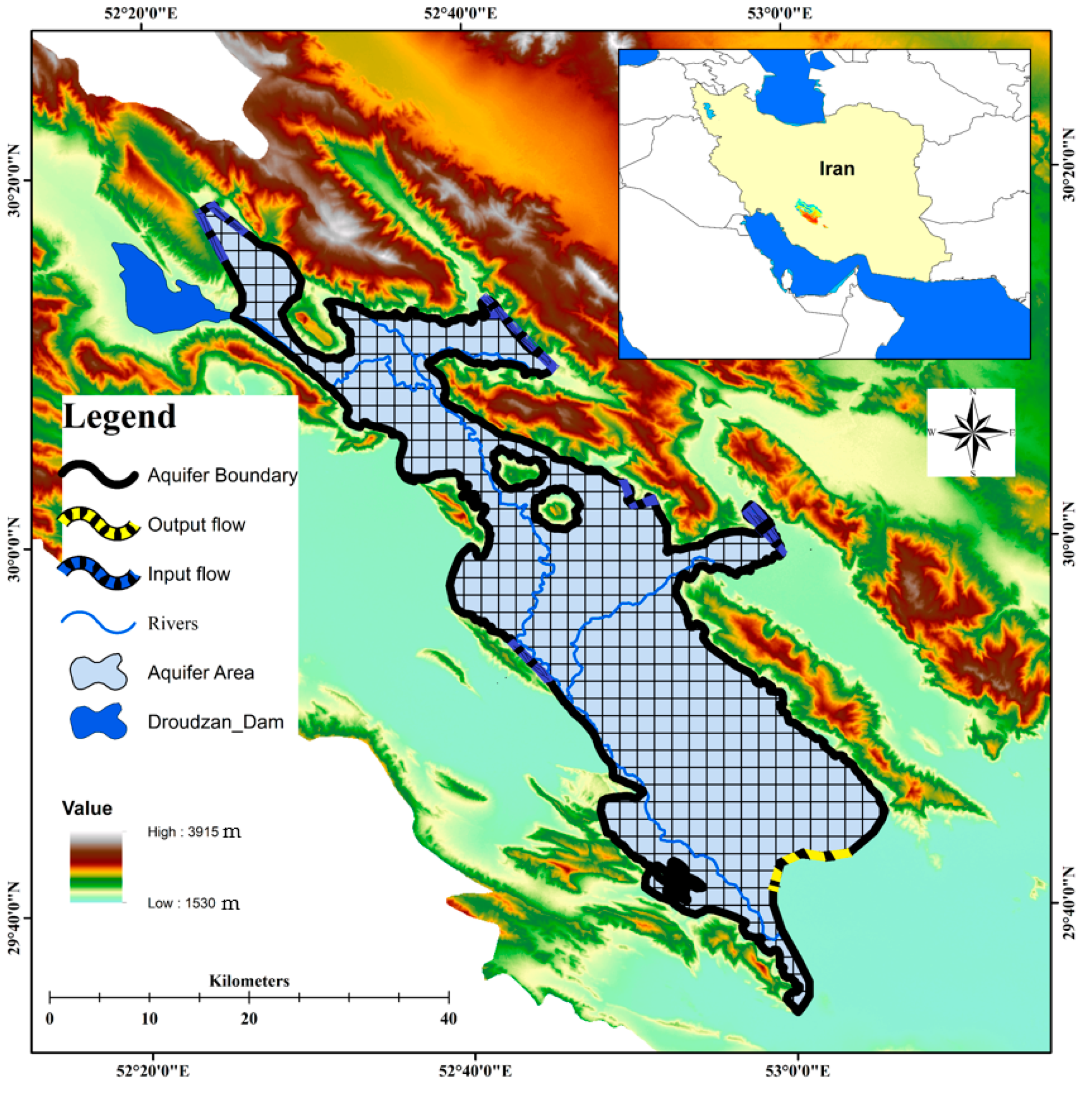
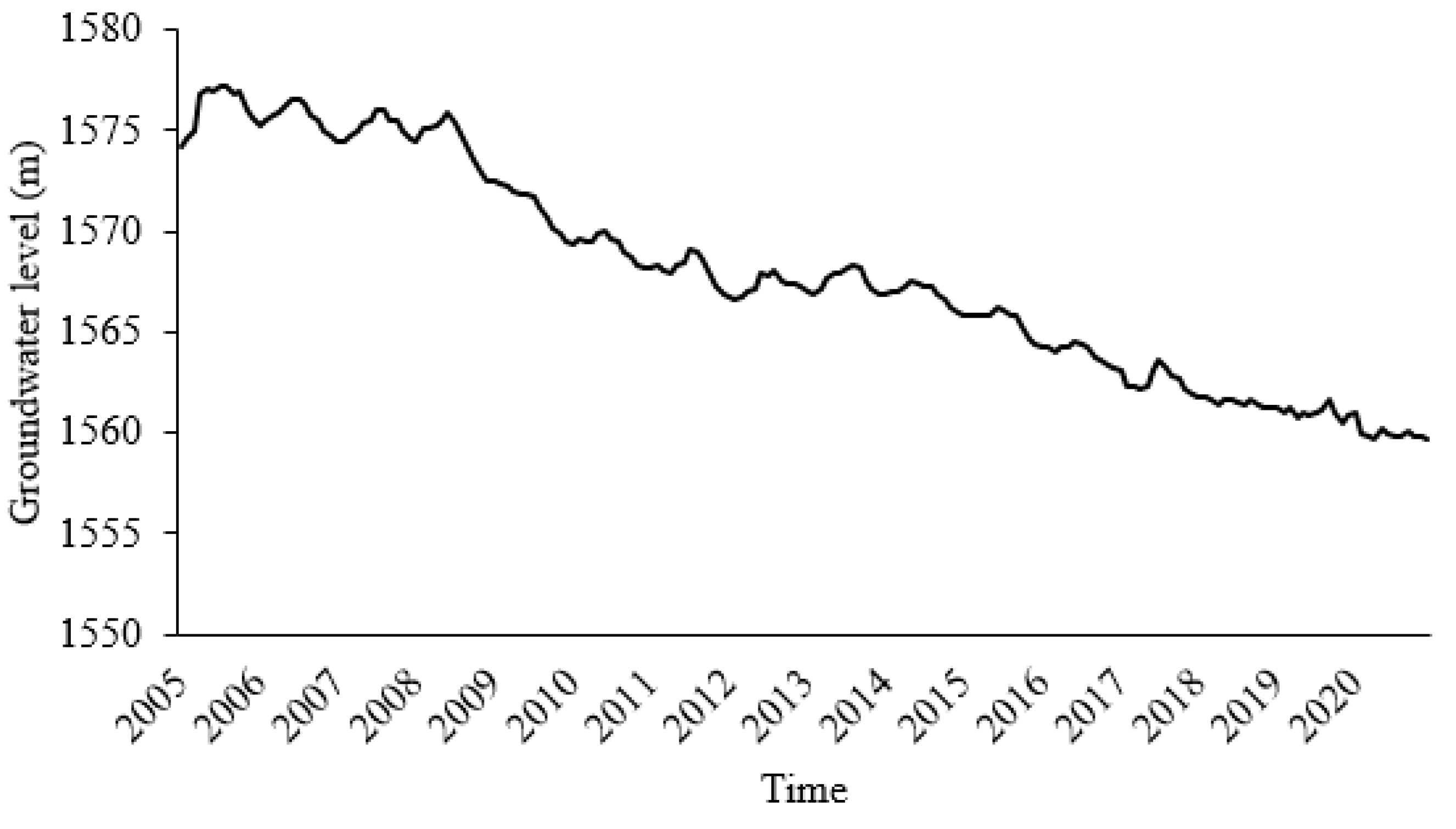
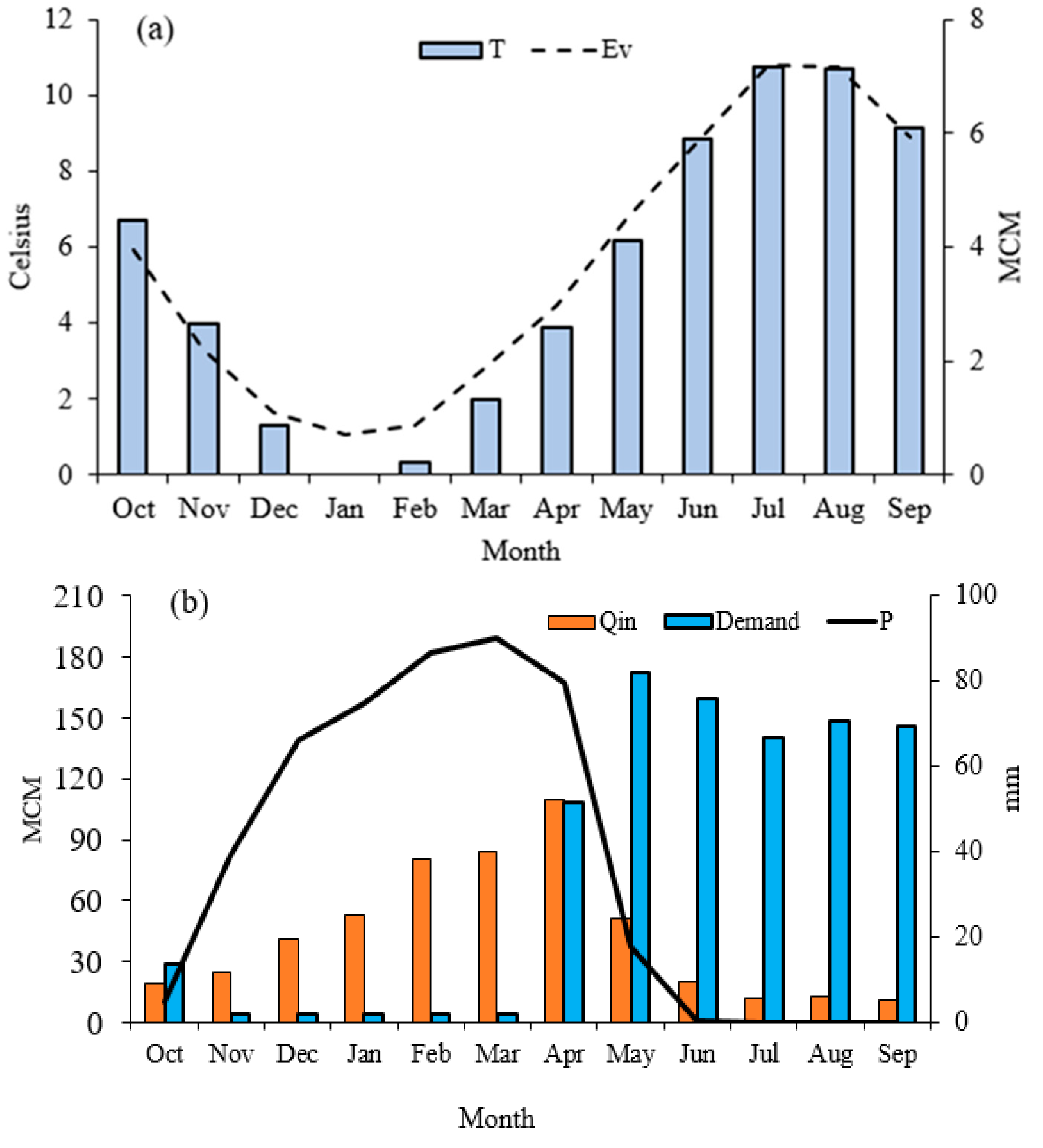
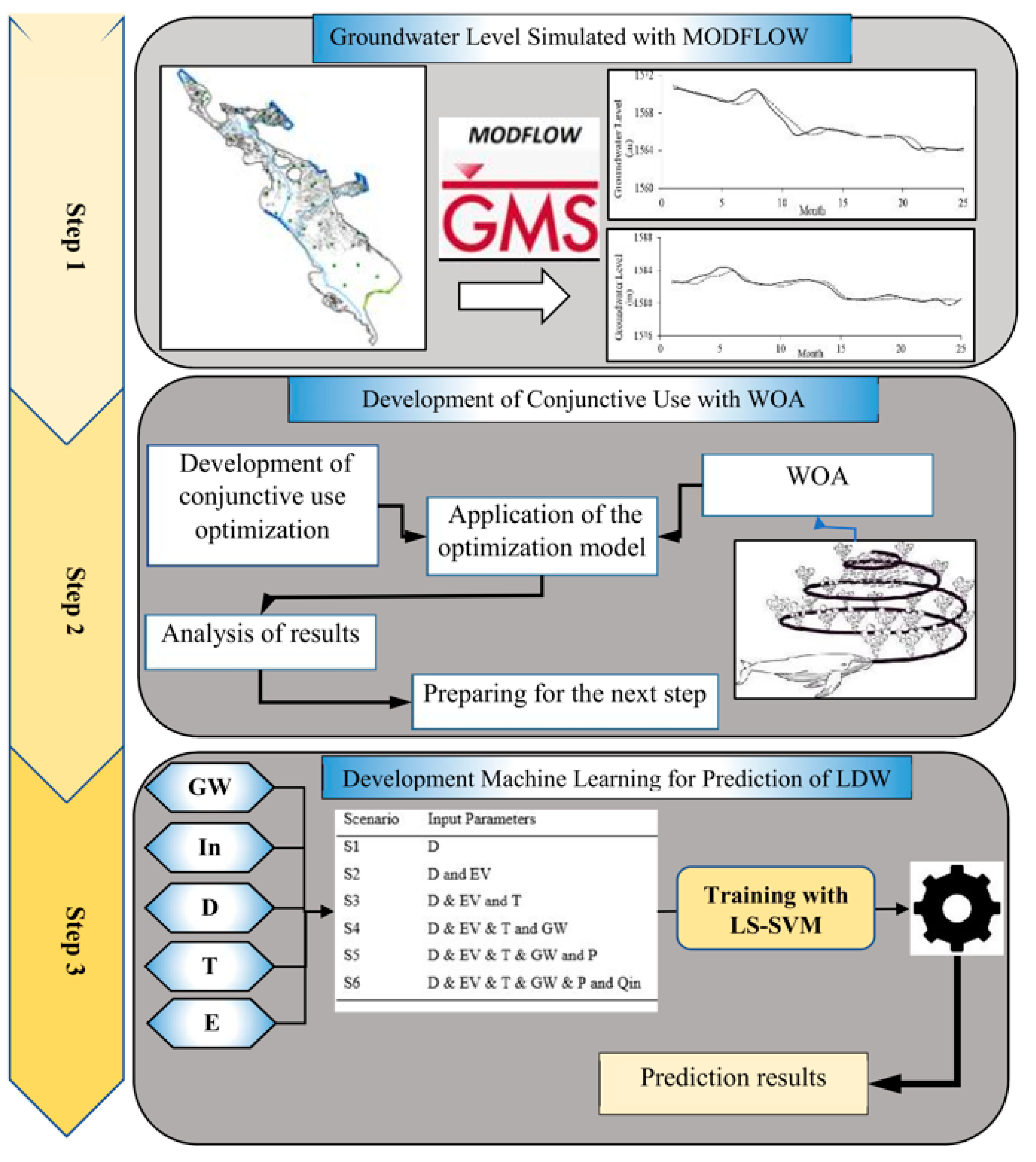
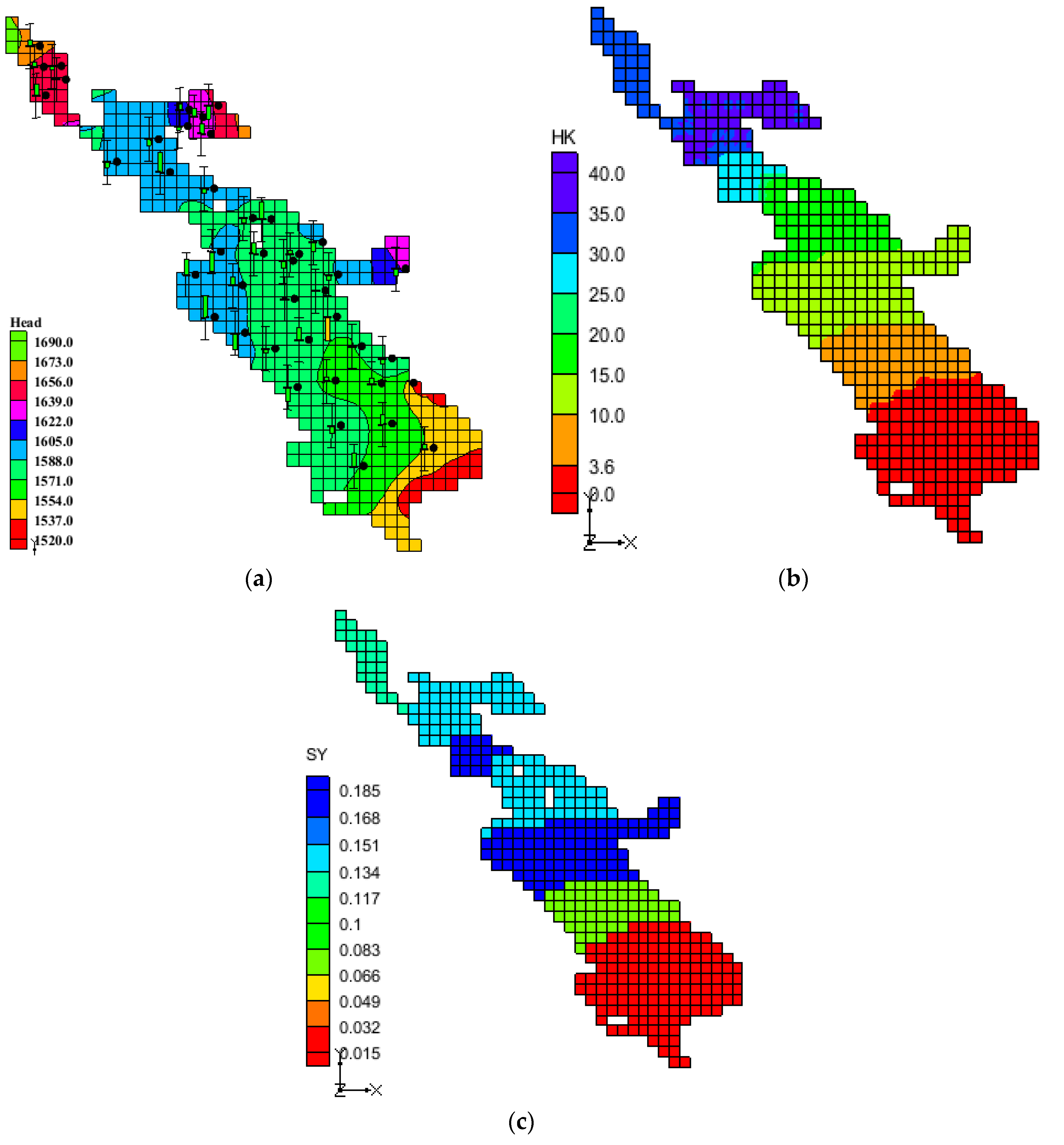
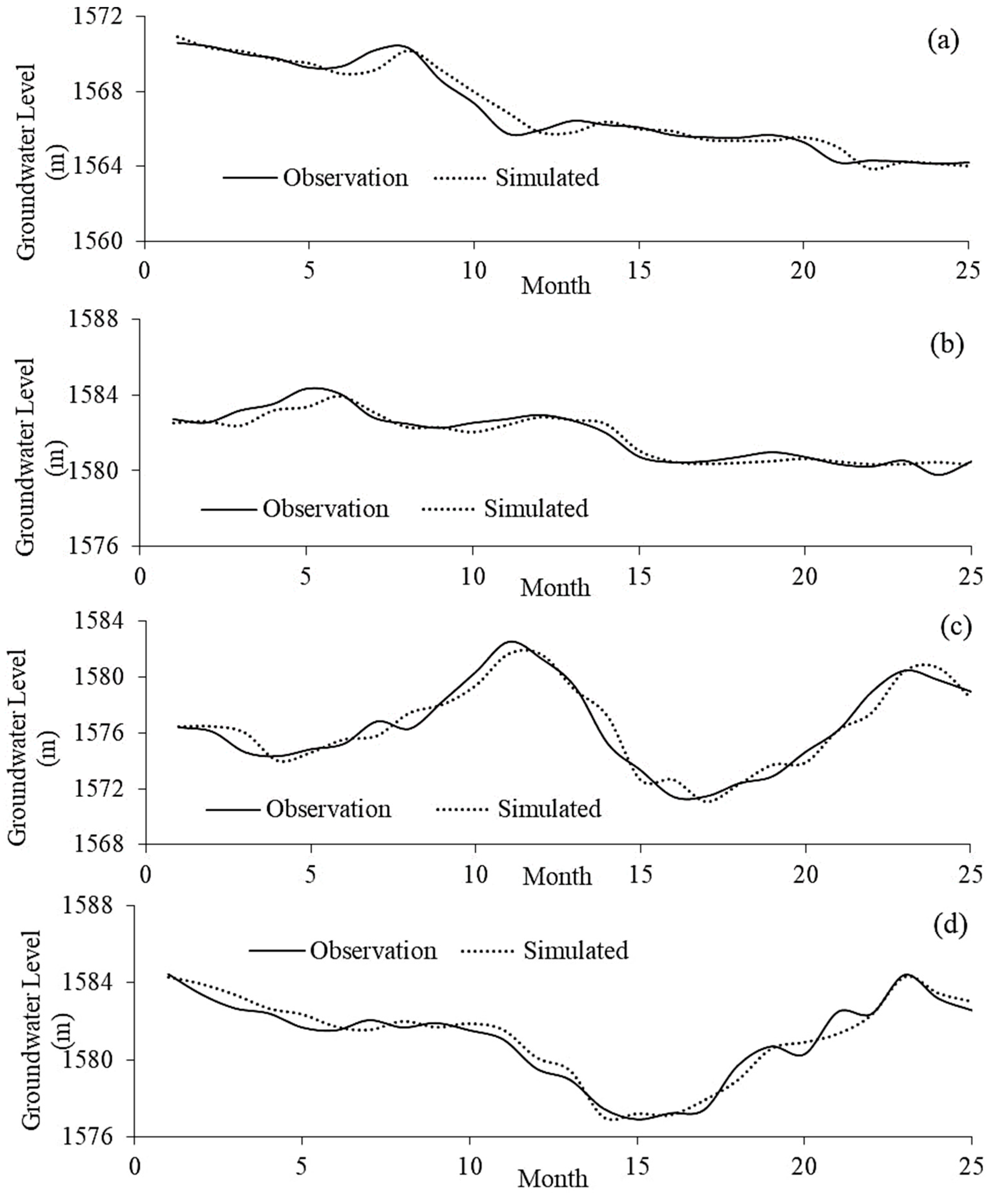

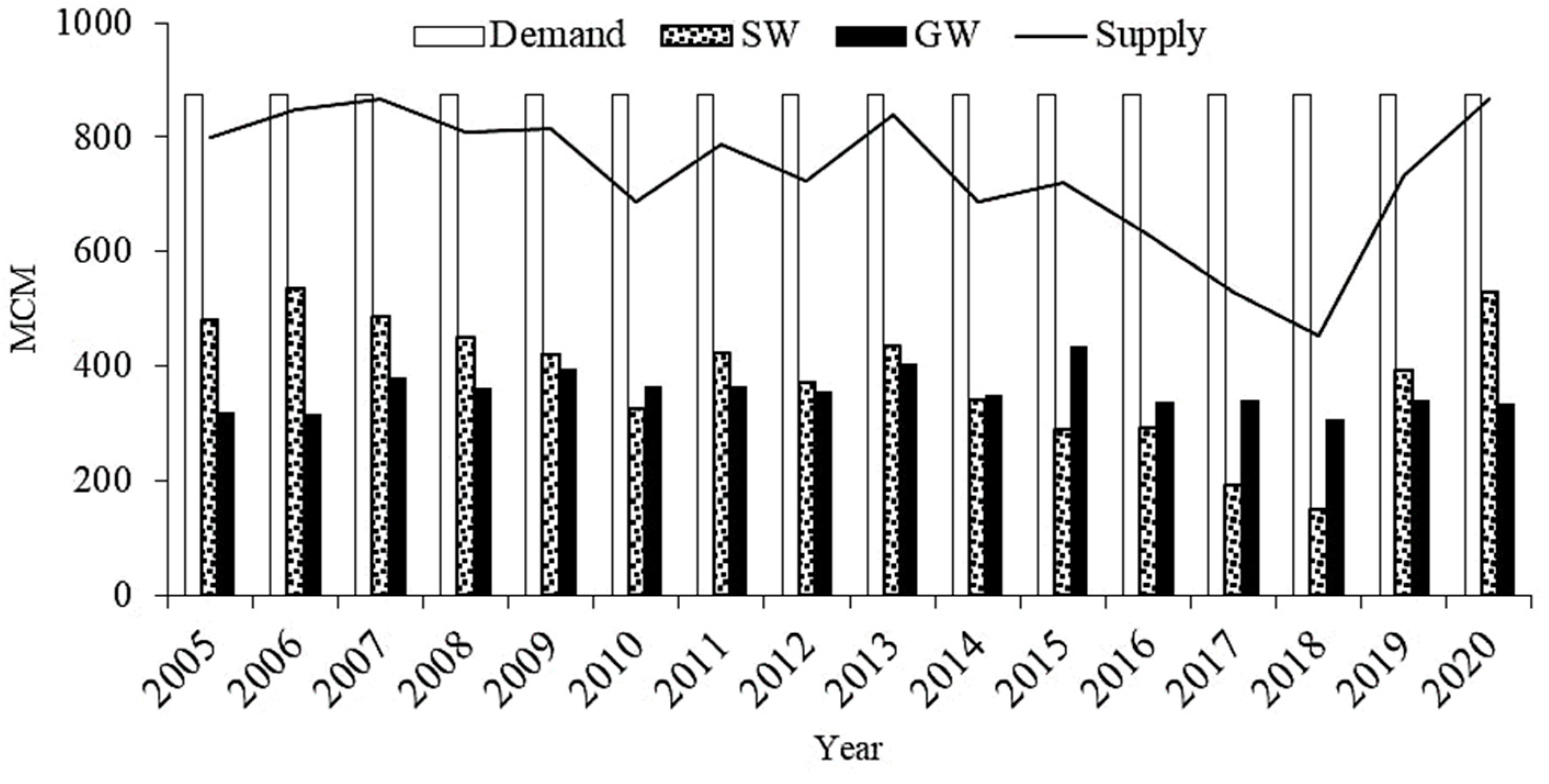


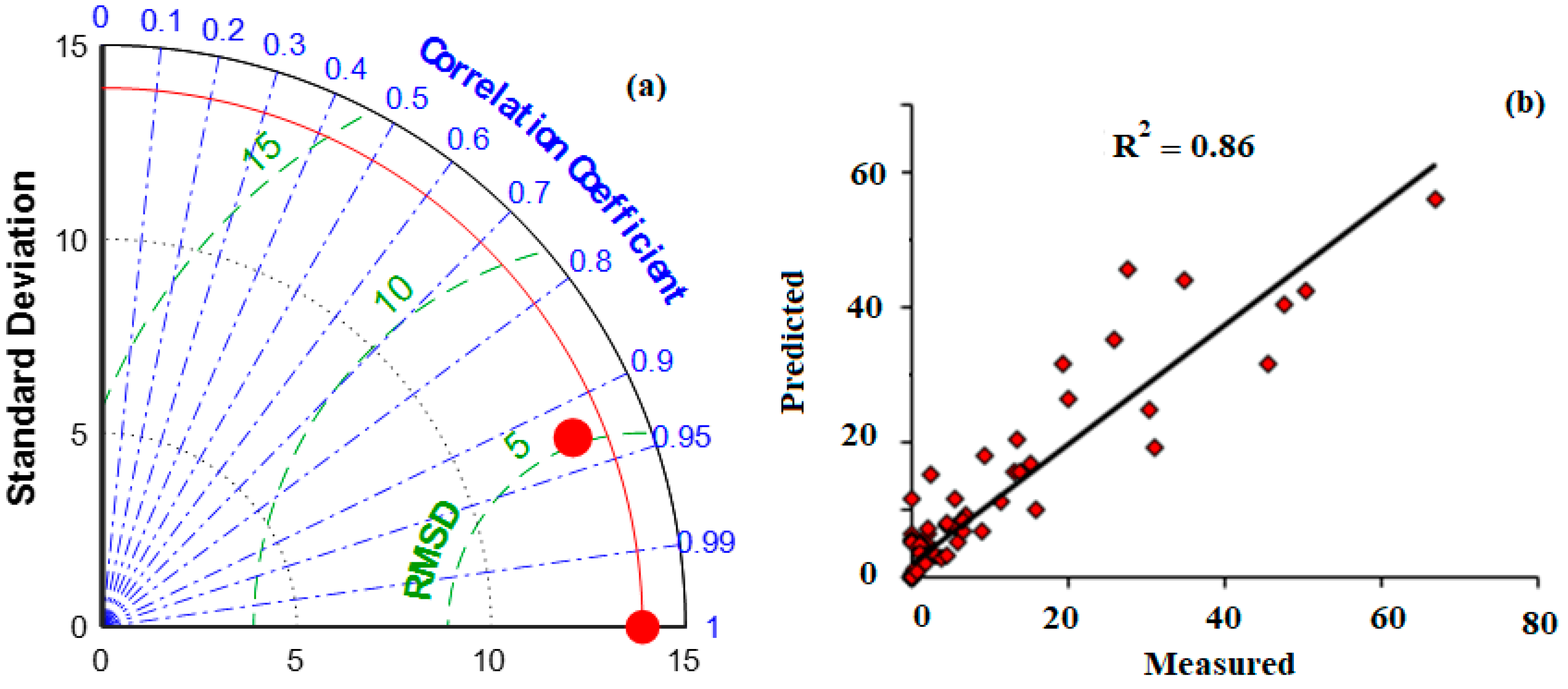
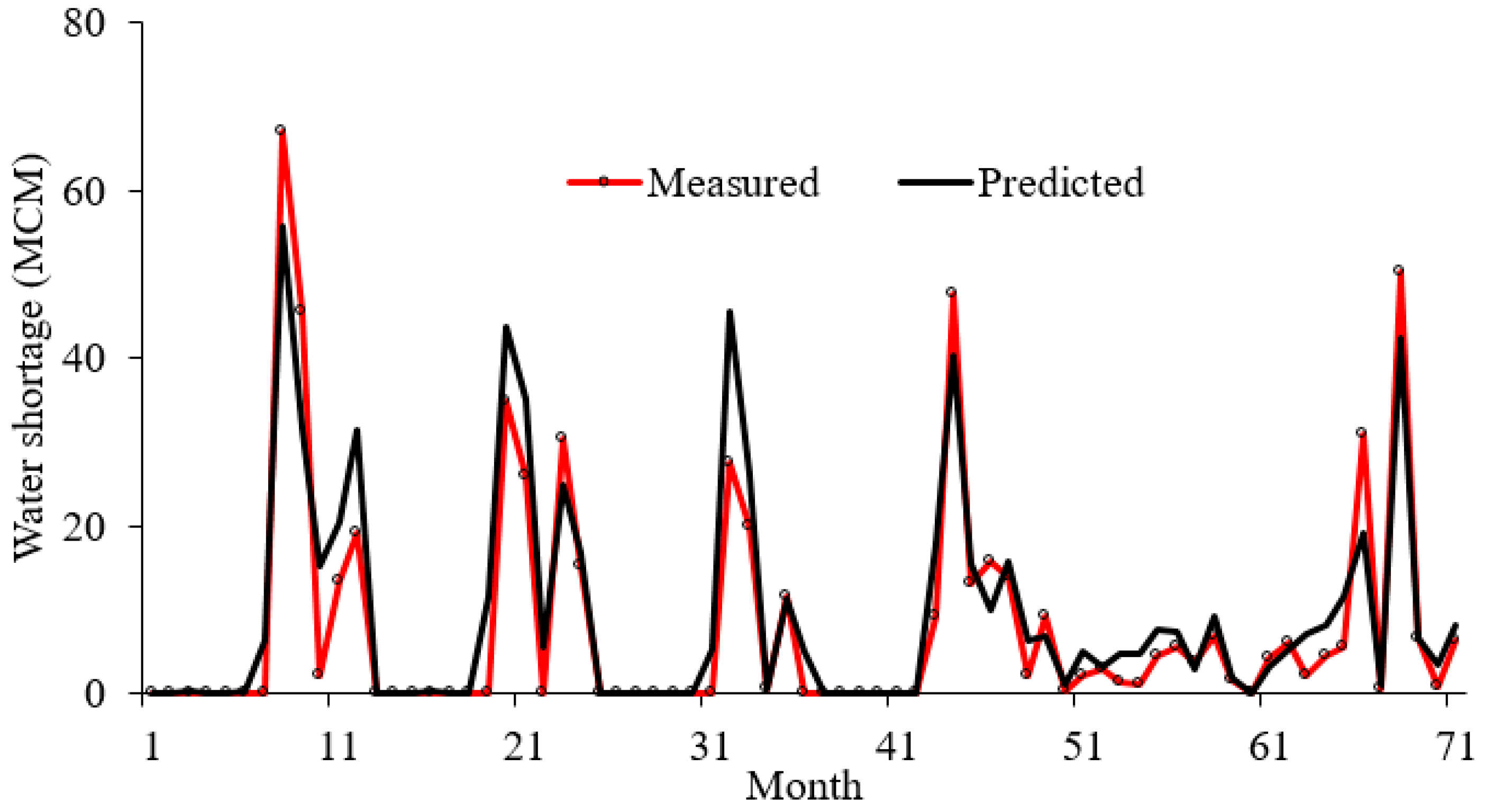
| Parameter | P | T | Ev | D | Qin | GW | Water Shortage |
|---|---|---|---|---|---|---|---|
| Water shortage | −0.33 | 0.54 | 0.62 | 0.69 | −0.25 | 0.47 | 1 |
| Scenario | Input Variable(s) | Output |
|---|---|---|
| S1 | D | water shortage |
| S2 | D and E | |
| S3 | D, E, and T | |
| S4 | D, E, T, and GW | |
| S5 | D, E, T, GW, and P | |
| S6 | D, E, T, GW, P, and Qin |
| State | R2 | RMSE (m) | MAE (m) |
|---|---|---|---|
| Steady | 0.99 | 0.89 | 0.76 |
| Unsteady | 0.99 | 0.93 | 0.89 |
| Validation | 0.98 | 1.12 | 0.93 |
| Year | Allocation (%) | Supply (%) | Year | Allocation (%) | Supply (%) | ||
|---|---|---|---|---|---|---|---|
| SW | GW | SW | GW | ||||
| 2005 | 60 | 40 | 91.6 | 2013 | 52 | 48 | 96.0 |
| 2006 | 63 | 37 | 97.3 | 2014 | 49 | 51 | 78.7 |
| 2007 | 56 | 44 | 99.0 | 2015 | 40 | 60 | 82.7 |
| 2008 | 56 | 44 | 92.7 | 2016 | 47 | 53 | 71.9 |
| 2009 | 52 | 48 | 93.3 | 2017 | 36 | 64 | 60.7 |
| 2010 | 47 | 53 | 78.7 | 2018 | 33 | 67 | 51.8 |
| 2011 | 54 | 46 | 90.2 | 2019 | 53 | 47 | 83.8 |
| 2012 | 51 | 49 | 83.6 | 2020 | 61 | 39 | 99.0 |
| Scenario | RMSE (MCM) | MAPE (MCM) | NSE | |||
|---|---|---|---|---|---|---|
| Training | Test | Training | Test | Training | Test | |
| S1 | 18.60 | 21.93 | 10.55 | 13.65 | 0.68 | 0.58 |
| S2 | 14.55 | 18.50 | 10.21 | 12.38 | 0.75 | 0.67 |
| S3 | 10.3 | 11.45 | 8.35 | 8.14 | 0.84 | 0.74 |
| S4 | 6.80 | 6.30 | 5.68 | 4.60 | 0.92 | 0.88 |
| S5 | 7.80 | 6.80 | 6.32 | 4.20 | 0.91 | 0.86 |
| S6 | 6.22 | 5.70 | 5.45 | 3.43 | 0.92 | 0.89 |
Publisher’s Note: MDPI stays neutral with regard to jurisdictional claims in published maps and institutional affiliations. |
© 2022 by the authors. Licensee MDPI, Basel, Switzerland. This article is an open access article distributed under the terms and conditions of the Creative Commons Attribution (CC BY) license (https://creativecommons.org/licenses/by/4.0/).
Share and Cite
Kayhomayoon, Z.; Milan, S.G.; Arya Azar, N.; Bettinger, P.; Babaian, F.; Jaafari, A. A Simulation-Optimization Modeling Approach for Conjunctive Water Use Management in a Semi-Arid Region of Iran. Sustainability 2022, 14, 2691. https://doi.org/10.3390/su14052691
Kayhomayoon Z, Milan SG, Arya Azar N, Bettinger P, Babaian F, Jaafari A. A Simulation-Optimization Modeling Approach for Conjunctive Water Use Management in a Semi-Arid Region of Iran. Sustainability. 2022; 14(5):2691. https://doi.org/10.3390/su14052691
Chicago/Turabian StyleKayhomayoon, Zahra, Sami Ghordoyee Milan, Naser Arya Azar, Pete Bettinger, Faezeh Babaian, and Abolfazl Jaafari. 2022. "A Simulation-Optimization Modeling Approach for Conjunctive Water Use Management in a Semi-Arid Region of Iran" Sustainability 14, no. 5: 2691. https://doi.org/10.3390/su14052691
APA StyleKayhomayoon, Z., Milan, S. G., Arya Azar, N., Bettinger, P., Babaian, F., & Jaafari, A. (2022). A Simulation-Optimization Modeling Approach for Conjunctive Water Use Management in a Semi-Arid Region of Iran. Sustainability, 14(5), 2691. https://doi.org/10.3390/su14052691









